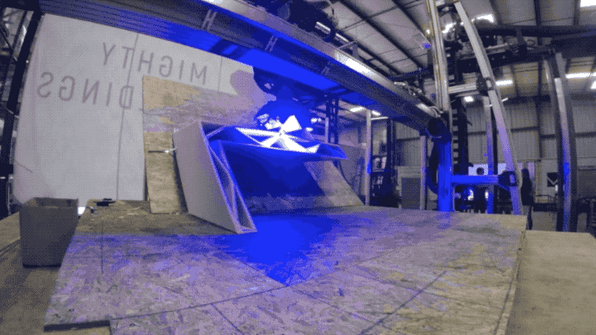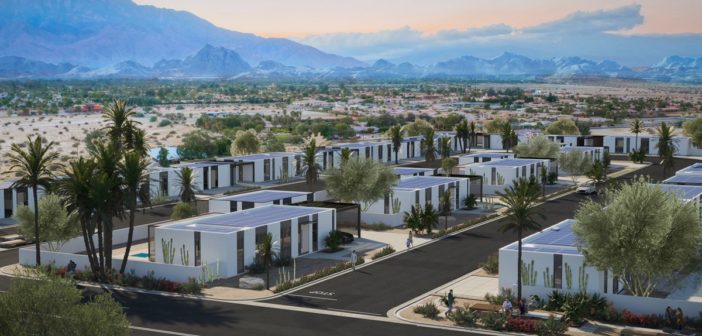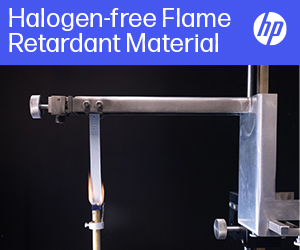Earlier this year, it was announced that housing developer Palari Group had partnered with additive construction startup Mighty Buildings to 3D print 15 homes in Rancho Mirage, California. However, the project has hit a small roadblock when city officials determined that the houses wouldn’t be allowed under state building codes, according to the Desert Sun.
The “world’s first” 3D printed housing community was unveiled in March 2021, with Palari CEO Basil Starr explaining that the company had acquired five acres for 15, three-story, 3D printed homes. Starr has since elaborated that the purchase is still in escrow and is set to close in June. And, while Mighty Buildings has 3D printed smaller buildings within state approval, this would represent the startup’s foray into larger homes.
Unfortunately for the project, Might Buildings’ “light stone material” has not yet received state approval. The material is a mix of polymers and minerals that are cured under ultraviolet light. For Rancho Mirage, this material would incorporate fiber reinforcement for greater strength. Mighty Buildings can obtain either local approval for the material, which allowed the project to go forward in Rancho Mirage, or state approval, which would place less pressure on the municipality in case of any issues that arise.
Mighty Buildings co-founder Sam Ruben told the Desert Sun, “We’re not anticipating any issues (with approvals on the new material) based on our experience with our first material and designs… By [getting state approval], we take the liability away from the city and the state takes on that liability for that approval. [That] can make things easier for the city in that regard since they’re not on the hook the same way they would be for the local approval.”

The Mighty Buildings construction process, featuring UV curing for the polymer portion of the mixture. Image courtesy of Mighty Buildings.
The Marketing Director for Rancho Mirage told the newspaper that the city has to rely on state building codes. Based on the standards of the California Department of Housing and Community Development, the material must be “at least the equivalent of that prescribed in the California Building Standards Code or (the State Housing Law) in performance, safety, and for the protection of life and health.”
The city is currently awaiting proof from Palari that 3D printed homes are approved by the state or another governing agency, such as the California Building Codes Association. This agency would examine Mighty Buildings’ 3D printed walls to determine if they met standards associated with structural integrity, load testing and weatherproofing.
Palari is in the process of reviewing the proposed designs to ensure that they meet code. When the company’s construction documents were submitted by the city to a third party, EsGil, to review if they could legally be built in California, EsGil said that there wasn’t enough information to make that determination.

The Cinco, a 3D printed single-family housing kit, will be used as the basis for the new development (Image via Mighty Buildings).
The Desert Sun article contains what appear to be veiled threats by Palari to take the project elsewhere if Rancho Mirage doesn’t approve the project quickly enough. Though the company hasn’t yet acquired land in these regions, Starr told the local newspaper that they included areas in the San Fernando Valley, San Luis Obispo, Monterey and San Francisco east bay. So far, Palari is already working on projects in Palm Springs, California, where the firm applied for a land-use permit to display a smaller accessory dwelling unit downtown that will be approved shortly, according to a city representative.
However, Starr did tell the paper, “What we have learned is that perhaps the city of Rancho Mirage is a little bit more conservative than we initially anticipated. We’re expecting to get approvals in place by the end of the year and then break ground in January.”
As discussed in our previous article on the project, the homes designed for the Rancho Mirage development are made up of 1,450-square-foot, three-bedroom, two-bath models, some with 700-square-foot casitas. They would range from $595,000 for a single house or $850,000 for those built with a casita.
The homes are meant to be net zero, in terms of energy usage, through the installation of solar panel systems. The 3D printing process itself is billed as producing 99 percent less waste than a traditional, wood-frame home that makes two tons of waste during construction.
While Palari’s CEO said that it had 15 custom home projects “in process” throughout the Coachella Valley, such as in Joshua Tree, Yucca Valley, and Palm Springs, the Desert Star could not confirm that any of these were far enough along to have reached the permitting stage.
Mighty Buildings takes the practical approach of 3D printing the elements of its buildings off-site, where the fabrication environment is much more easily controlled. Though there have been many claims about the benefits of additive construction, such as the ability to address the affordable housing crisis, the technology has not yet reached a scale where those benefits are easily demonstrable.
The Rancho Mirage project may have temporarily hit a setback, but Mighty Buildings has received significant funding and will likely continue to 3D print housing units, small or large, when it finds an amenable city partner. Meanwhile, Saint-Gobain has recently made a big investment into additive construction, possibly for the production of concrete formwork, and ICON has continued development on its gantry-style cement 3D printer.
As these businesses progress, they will need to come face-to-face with the regulations of the construction industry. Just as, in the case of medical 3D printing, one-off devices or individual classes of devices have received regulatory approval, individual construction projects may receive approval on a case-by-case basis until the technology and the industry surrounding it can come eye-to-eye.
Subscribe to Our Email Newsletter
Stay up-to-date on all the latest news from the 3D printing industry and receive information and offers from third party vendors.
You May Also Like
Formlabs Form 4L 3D Printer Review: Scaling Success with Speed and Precision
Disclosure: The Form 4L was provided to me by Formlabs free of charge for the purpose of this review. I have not received any other compensation. All opinions expressed are...
How One Month Will Reshape the 3D Printing Industry
As 3DPrint.com readers retreated to their homes to kick off the holiday season, numerous developments occurred within the additive manufacturing (AM) sector that will surely change the overall shape of...
The Top 10 Most Popular 3D Printing Stories of 2024
Despite the doom and gloom that some experienced in 2023, the past year has been transformative for additive manufacturing (AM), with numerous stories capturing the attention of professionals and enthusiasts...
Airtech to Supply Materials for KraussMaffei Large Format 3D Printers
Specialty manufacturer Airtech Advanced Materials Group is rapidly conquering the large and medium format 3D printing sector. The company has formed a partnership with Ascent Aerospace to incorporate its materials...
































